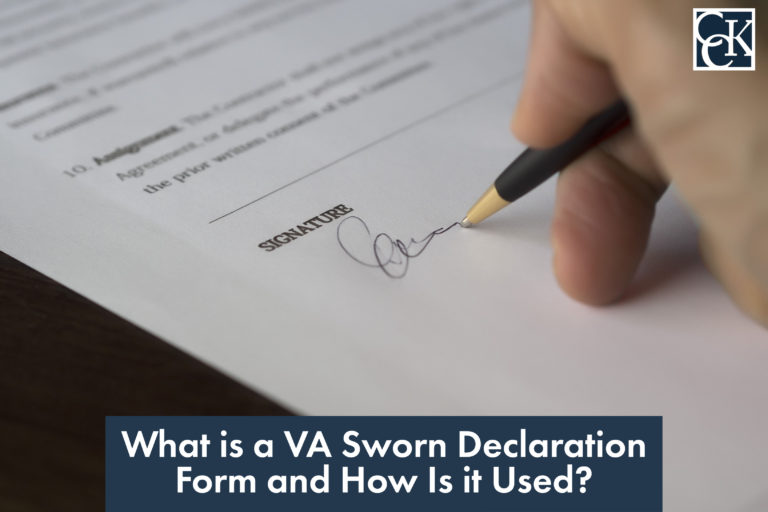What Is a VA Sworn Declaration Form and How Is it Used?

CCK Law: Our Vital Role in Veterans Law
VA Form 21-10210: Lay/Witness Statement
A VA sworn declaration is a letter or statement in support of a veteran’s claim. Sworn declarations are usually written by a layperson or someone without medical expertise. A layperson generally can be a relative, spouse, friend, co-worker, or fellow servicemember.
Using Form 21-10210, the veteran or a layperson can submit a sworn declaration. The overall purpose of the form is for someone who knows the veteran well to speak to the impact of their claimed condition.
Specifically, the individual should be able to adequately describe the onset and progression of the veteran’s condition and how it has negatively affected their social and occupational functioning. Importantly, veterans can also submit a VA sworn declaration form on their own behalf and certify that their testimony is both truthful and accurate.
What is Lay Evidence?
Lay evidence refers to written statements provided by a veteran, or those familiar with the veteran’s situation, that aim to help prove a claim for VA disability benefits. Lay evidence, commonly referred to as lay statements or buddy statements, can be valuable and versatile pieces of evidence to prove various types of claims.
Lay evidence is used to help bolster a veteran’s case and can be particularly useful for filling gaps of information missing from treatment records or service records. Lay evidence can also be used to provide clarifying information to better illustrate the veteran’s current condition.
When to Use a VA Sworn Declaration
In claims or appeals for service connection, lay evidence can be used to describe the in-service event, injury, or illness that caused the veteran’s disability. Lay evidence can also be used to support a claim or appeal for an increased rating by detailing the veteran’s symptoms, their severity, and progression over time.
Veterans unable to work due to service-connected conditions can use lay evidence to help prove entitlement to individual unemployability benefits by describing the impact these conditions have on their ability to work.
Specifically, VA sworn declarations may be helpful when filing for service connection, increased ratings, or individual unemployability benefits as mentioned above. However, a VA sworn declaration can be used to do the following as well:
- Fill in the gaps of an original statement. If a veteran originally submitted a lay statement but left out important details, a VA sworn declaration can be used to account for the missing information.
- To support a lack of medical evidence. If veterans were unable to seek medical attention during service, a VA sworn declaration can help establish the details of what happened. Veterans can describe where they were serving, the event that took place, and the symptoms they experienced. Importantly, service personnel records may help corroborate the timeline and location given in the veteran’s statement.
- To correct or clarify the record. Veterans should always review their VA claims file to ensure that all information is accurate and accounted for. If this is not the case, they can consider submitting a VA sworn declaration form to correct or clarify the record.

What Form Can Be Used for a VA Sworn Declaration?
VA Form 21-10210
A VA sworn declaration needs to be filled out on VA Form 21-10210 in order to be considered formal and valid. The form requires that the person writing the statement certifies that it is true and correct to their best knowledge.
Sworn Declaration Is Under Oath
When filling out VA Form 21-10210 and submitting a sworn declaration, veterans will notice the wording “under penalty of perjury.” This means that the author of the form (i.e., the veteran or other layperson) is legally certifying the statement therein, similar to making a promise under oath. Here, the purpose is to guarantee that the contents of the declaration are factual and that the individual is telling the truth in the eyes of the law. If VA can prove that the author of the declaration is lying, they may be subject to legal consequences.
With this being said, VA sworn declaration forms may hold significant weight in the eyes of VA adjudicators for that reason. They demonstrate that the author fully believes that the information they are providing is accurate. Furthermore, the author is attesting that their statements are true while also being fully aware of the possible penalty of perjury or serious legal trouble. As such, the VA adjudicator may consider the gravity of the statement when making a decision.
It is important to note that a VA sworn declaration does not need to be notarized in order to be considered official.
How to Fill Out VA Form 21-10210
Filling out a VA sworn declaration form is rather simple and straightforward seeing as there are only three sections. The first section asks for the veteran’s identification information, including the following:
- Full name
- Social security number
- VA file number
- Date of birth
- Telephone number
- Email address (optional)
- Mailing address
The second section should be filled out if the person filing the claim is not the veteran. For example, if a surviving spouse is filling for benefits relating to the veteran, they should fill out this section.
The third section is reserved for the statement. Here, the veteran, or layperson, will include their formal declaration or statement.
Lastly, by signing and dating, the person writing the statement is certifying that the statements on the form are true and correct to the best of their knowledge and belief. Underneath the signature line is the statement regarding the penalty for perjury to remind veterans of the oath they are taking prior to signing the form.
About the Author
Share this Post

